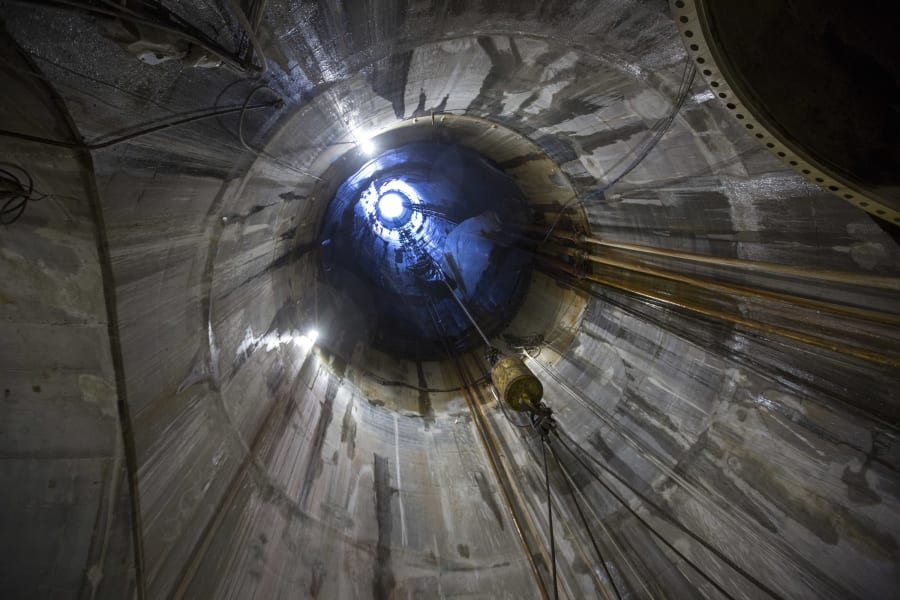t seems like a simple question: How many people can Southern Nevada support with the water it has now?
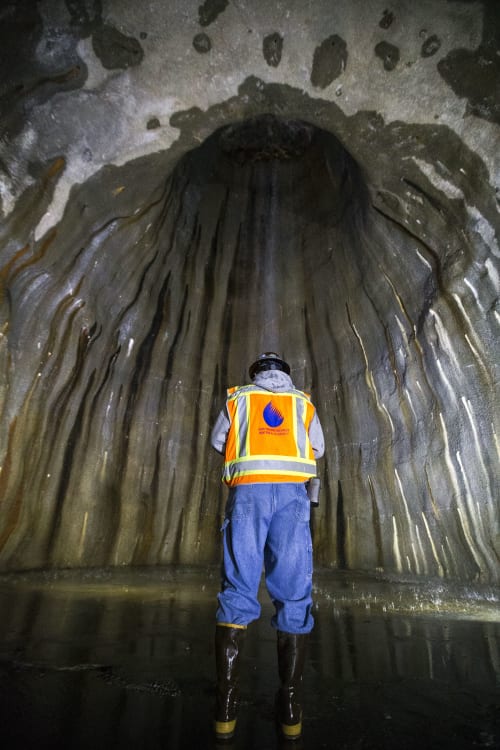
Andrew Contreras of the Southern Nevada Water Authority during a tour of SNWA's low-lake-level pumping station at Lake Mead National Recreation Area on in November 2018. (Richard Brian/Las Vegas Review-Journal)
But the answer is far from easy.
The number can swing wildly depending on a host of variables, including the community’s rates of growth and conservation and the severity of drought on the Colorado River.
A sharp drop in Lake Mead could trigger deep cuts on the Colorado, leaving Las Vegas with less water. An unexpected surge in population could boost demand beyond what the river can provide. Both of those things at once could wipe out the community’s reserves and send local officials scrambling to develop new water resources.
The Southern Nevada Water Authority must consider the whole spectrum of possible scenarios in its annual Water Resource Plan, a running blueprint for where the community will get its water for the next 50 years.
“We try to do bookends,” said Colby Pellegrino, director of water resources for the agency. “What’s a good population estimate? What’s a robust population estimate? What’s a happy Colorado River picture, and what’s a really bad Colorado River picture? And we know we’re going to land somewhere in the middle of those.”
With Lake Mead inching toward shortage and river users facing a March 19 federal deadline to submit plans to voluntarily trim their use, such long-range planning has never been more important or less certain.
Worst-case scenario
But if it’s numbers you want, here’s one for you: 2,554,000.
That is the number of people the authority believes it can serve with the existing water supply if Las Vegas booms just as everything goes wrong on the Colorado River.
“Sort of our worst-case scenario is dire hydrology but robust economic growth,” said John Entsminger, the authority’s general manager. “I don’t know if that meets everyone’s definition of a worst-case scenario or not, but for us to stress-test our water portfolio, those are the knobs we have to turn.”
The 2.5 million figure, roughly 300,000 higher than today’s population, assumes a catastrophic drop in Lake Mead and an escalating series of shortages that would eventually force Nevada to cut its meager, 300,000-acre-foot share of the Colorado by as much as 40,000 acre-feet a year.
Pellegrino said that’s double the cuts Nevada faces under the current rules governing the river, but it’s not out of the realm of possibility should Lake Mead continue its decline.
With a sudden spike in the valley’s population at the same time, the community could outgrow its diminished share of river water — and the roughly 45,000 acre-feet of local groundwater it uses annually — as soon as 2022. That would force the authority to dip into its water savings account far sooner than expected, shortening the life span of those all-important reserves.
Luckily, Pellegrino said, such a scenario seems highly unlikely, even on a river as unpredictable as the Colorado.
“We know even in bad hydrology we’re going to float in and out of shortage,” she said. “But again, we’re going for that bookend.”
Normal or not
Here’s another number for you: 2,966,600.
Assuming there are no shortages, unexpected growth spurts or lags in conservation, that’s how many county residents the authority believes it can supply with its full complement of Colorado River water and the valley’s own groundwater aquifer.
This represents the sunniest — and perhaps least likely — scenario covered in the 2018 Water Resource Plan, which the authority’s board approved in November. It is the only scenario in which the community, while still growing at a modest clip, makes it through the next 50 years without having to tap into the 1.8 million acre-feet of water it has banked for future use.
Watch: How many people can Southern Nevada’s water sustain?
The number of county residents who can be served with current supplies drops to 2.71 million when you factor in up to 20,000 acre-feet in annual cuts Nevada is expected to take, perhaps as soon as next year, should Lake Mead continue to drop.
Under that scenario, the authority would tap into its water savings account for the first time in 2039.
The authority’s resource plan is built around population forecasts from UNLV’s Center for Business and Economic Research. The Regional Transportation Commission and the Southern Nevada Regional Planning Commission use the same projections to guide their future plans.
UNLV Professor Steve Miller, who serves as director of the center, said the forecasts are developed using a highly sophisticated modeling program that accounts for everything from nationwide migration patterns to future plans for large local commercial and public works projects that could attract workers. The latest forecast calls for roughly 2 percent annual growth over the next couple of years — a robust rate for most communities, but only about half what Southern Nevada was experiencing before the Great Recession, he said.
Miller stands behind the center’s forecasts, of course, but offered an important caveat: “Las Vegas has always had a pattern of outperforming expectations, and that applies to population (growth) as well,” he said. “There’s a saying in the forecasting business: often wrong but never in doubt.”
To hedge against a potential boom, the authority also runs water supply projections with up to 25 percent more growth than the center’s forecast, Pellegrino said.
There’s a saying in the forecasting business: often wrong but never in doubt.
Steve Miller, professor and director of UNLV’s Center for Business and Economic Research
That higher growth rate, combined with 20,000 acre-feet a year in shortage cuts on the river, could force the community to begin withdrawing water from its reserves by 2025.
All of the authority’s projections include a steady decline in per capita water use as a result of conservation.
Valley residents currently use about 127 gallons per capita per day, down from about 200 gallons 15 years ago. The authority hopes to cut per capita use by another 11 gallons a day by 2035 — a goal now baked into its water resource plans.
Exceed that goal, and the community could stretch its resources even further. Fall short, and the water could run out sooner than expected.
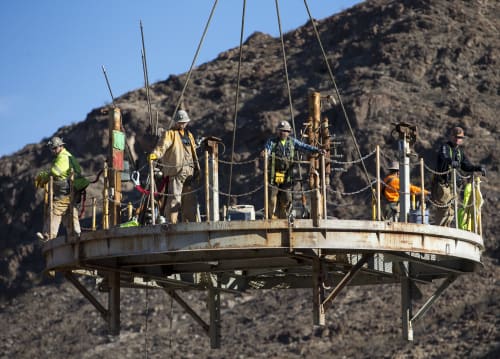
Workers prepare to be lowered down the access shaft for Southern Nevada Water Authority's low-lake-level pumping station at Lake Mead National Recreation Area in November 2018. (Richard Brian/Las Vegas Review-Journal)
The outer limits
Here’s one more number to consider: 3,254,164.
This represents the outer limits of how many people can be supported by the current water supply and banked reserves, according to the latest resource plan.
Depending on the growth rate, Clark County could reach this population threshold in as little as 25 years or not get there for a half-century or more. Whenever that day arrives, the authority will need to have some new, permanent source of water at the ready beyond the river and the community’s savings accounts.
That is the whole point of having a 50-year plan and updating it annually, Entsminger said. “It gives you a multi-decadal planning horizon to either bring in new resources, to have even more aggressive conservation and demand management, or some combination of those two things,” he said.
But predicting the future can be difficult.
Just look at the authority’s very first 50-year water resource plan, adopted in 1996.
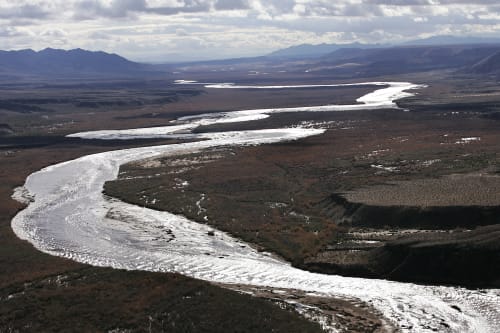
The swollen Virgin River flows south towards Lake Mead and Las Vegas following heavy rains in the area in December 2010. (Review-Journal file)
That 30-page document predicted the community would outgrow its existing water supply by 2010. To meet demand after that, the agency planned to tap Colorado River water going unused in Nevada and Arizona while it developed three new permanent resources: water piped in from the Virgin River, groundwater pumped from across eastern Nevada and a shallow layer of brackish groundwater pulled from just beneath the surface of the Las Vegas Valley.
But the pipelines to the Virgin River and eastern Nevada were never built. The valley’s shallow aquifer was never tapped. And not only was there still water available in 2010, but the community used less of it that year than it had in a decade.
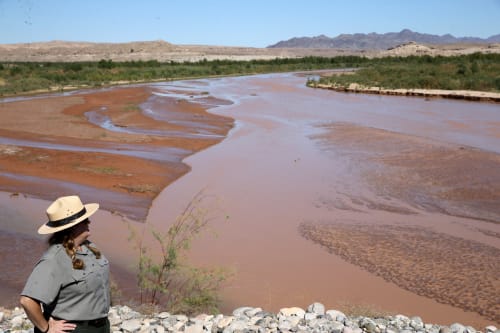
Lake Mead National Recreation Area spokeswoman Christie Vanover overlooks the Virgin River from the closed Overton Beach Marina in October 2018. Vanover said the lake has receded about a mile and a half away due to drought. (K.M. Cannon/Las Vegas Review-Journal)
This is why the authority updates its 50-year plan on an annual basis, Entsminger said.
“Our current water resource plan shows that, under normal conditions, our Colorado River resources are sufficient through 2068,” he said. “Through moderate shortages, our existing resources plus our banked resources are sufficient through 2068. And in a deep drought, where we were required to take twice the current federally mandated shortage every single year, then our Colorado River resources and our temporary resources are sufficient to get us through the mid-2040s, with additional conservation.”
In other words, the community still has water to grow on. And with some luck and careful use, that water could last for the next 50 years at least.
Which leads to a different question no easier to answer.
It’s not whether we can grow. It’s how we grow.
Contact Henry Brean at hbrean@reviewjournal.com or 702-383-0350. Follow @RefriedBrean on Twitter.




